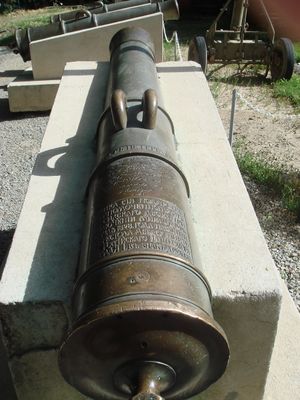معاهدة تركمنچاي
| معاهدة سلام بين روسيا القيصرية والامبراطورية الفارسية | |
|---|---|
 حدود شمال غرب إيران قبل وبعد المعاهدة | |
| المكان | تركمنچاي |
| تاريخ السريان | 22 فبراير 1828 |
| الموقعون | |
| الأطراف | |
معاهدة تركمنچاي (روسية: Туркманчайский договор؛ فارسية: عهدنامه ترکمنچای؛ إنگليزية: Treaty of Turkmenchay) كانت اتفاقية بين فارس (إيران حالياً) والامبراطورية الروسية، التي أنهت الحرب الروسية الفارسية (1826–28). وقد وُقـِّعت في 10 فبراير 1828 في تركمنچاي، إيران. وبمقتضى المعاهدة، تنازلت فارس لروسيا عن عدة مناطق في جنوب القوقاز: خانية إريڤان وخانية نخچوان وبقية خانية طاليش. وُضِعت الحدود بين روسيا وفارس عند نهر أراس. تلك الأراضي تضم ما هو اليوم أرمنيا، والأجزاء الجنوبية من جمهورية أذربيجان الحالية، ونخچوان وكذلك محافظة إغدير (التي هي اليوم جزء من تركيا).
المعاهدة وقـّعها عن فارس ولي العهد عباس مرزا واللهیار خان آصفالدوله، مستشار الشاه فتح علي (من أسرة قاجار)، وعن روسيا الجنرال إيڤان پاسكيڤتش. ومثل معاهدة گلستان 1813، فقد فرضت روسيا هذه المعاهدة، إثر انتصارها العسكري على فارس. فقد هدد پاسكيڤتش باحتلال طهران في خمسة أيام ما لم تُوقـَّع المعاهدة.[1]
وبهذه المعاهدة النهائية في 1828 ومعاهدة گلستان 1813، أنهت روسيا الاستيلاء على كل أراضي القوقاز من إيران، والتي تضم ما هو اليوم داغستان وشرق جورجيا وأذربيجان وأرمنيا، والذين كانوا جميعاً جزءاً من إيران لقرون طويلة.[2] المنطقة إلى الشمال من نهر آراس، ومنها الأراضي التي تشكل اليوم دول جورجيا وأذربيجان وأرمنيا وجمهورية داغستان في شمال القوقاز، كانت أرض إيرانية حتى احتلتها روسيا خلال القرن التاسع عشر.[3][4][5][6][7][8]
وكنتيجة مباشرة أخرى ومن أعقاب المعاهدتين، فإن الأراضي التي كانت فارسية أصبحت الآن جزءاً من روسيا لمدة 180 عاماً التالية، ماعدا داغستان، التي بقيت ضمن الأملاك الروسية منذ ذلك الحين. ومن الجزء الأعظم لتلك الأراضي، فقد تشكلت ثلاث أمم منفصلة من خلال حل الاتحاد السوڤيتي في 1991، بالذات جورجيا وأذربيجان وأرمينيا. وأخيراً وليس آخراً، فكنتيجة للمعاهدتين، فقد تم الفصل بحسم بين الأمتين، الأذربيجانيين و الطالش منذ ذلك الحين.
بنود المعاهدة
حسب المعاهدة:
- البند 4: تتنازل فارس عن خانية إريڤان (معظم ما هو اليوم وسط أرمنيا) وخانية نخجوان (معظم ما هو اليوم جمهورية نخجوان الذاتية التابعة لأذربيجان)، و خانية طاليش (جنوب شرق أذربيجان) ومناطق Ordubad و Mughan (التي هي الآن جزء من أذربيجان)، and also reiterated the cessions made to Russia in the معاهدة گولستان.
- البند 6: وعدت فارس أن تدفع لروسيا 10 كرور ذهباً أو 20 مليون روبل ذهبي (في نقود 1828).
- البند 7: Russia promised to support عباس مرزا as the heir to the throne of Persia on the death of شاه فتح علي. (This clause became moot when Abbas Mirza predeceased شاه فتح علي.)
- البند 8: Persian ships lost full rights to navigate all of the بحر قزوين وسواحله، henceforth given to Russia.
- Persia recognized capitulation rights for الرعايا الروس في فارس.
- البند 10: Russia gained the right to send consular envoys anywhere in Persia.
- البند 10: Persia must accept commercial treaties with Russia as Russia specified.
- البند 13: Prisoners of war were exchanged.
- Persia officially apologized for breaking its promises made in the Gulistan Treaty.
- البند 15: Shah Fath Ali Shah promised not to charge or persecute any inhabitant or official in the region of Iranian Azerbaijan for any deed carried out during the war or during the temporary control of the region by Russian troops. In addition, all inhabitants of the aforementioned district were given the right to move from Persian districts to Russian districts if they wished to do so within one year.
The treaty also stipulated the resettlement of Armenians from أذربيجان الإيرانية to the Caucasus, which also included an outright liberation of Armenians taken captive by Persia since 1804 or 1795.[9][10] This resettlement replaced the 20,000 Armenians who moved to Georgia between 1795 and 1827.[11]
الأعقاب
حسب البروفسور ألكسندر ميكابريدزه:
تحت البند الرابع من المعاهدة، تخلت إيران عن سيادتها على خانيات يريڤان ونخچوان وطالش و Ordubad, و Mughan بالاضافة إلى المناطق التي ضمتها روسيا تحت معاهدة گولستان (1813). وأُعلِن نهر أراس كحد بين إيران وروسيا. In articles 6-8, Iran agreed to pay reparations of 20 million rubles in silver and transferred to Russia the exclusive rights to maintain a Caspian fleet. In addition, the capitoluratory rights guaranteed Russia preferential treatment for its exports, which generally were not competitive in European markets. In article 10, the shah recognized Russia's right to send consulate envoys to anywhere in Iran. The Treaty of Turkmenchay was the definite acknowledgement of the Persian loss of the Caucasus region to Russia.[12]
حسب Cambridge History of Iran:
Even when rulers on the plateau lacked the means to effect suzerainty beyond the Aras, the neighboring Khanates were still regarded as Iranian dependencies. Naturally, it was those Khanates located closest to the province of Āzarbāījān which most frequently experienced attempts to re-impose Iranian suzerainty: the Khanates of إريڤان ونخچوان وقرة باغ عبر نهر أراس، خانية طالش وراء الآراس، بعاصمتها الادارية في لنكران ولذلك كانت عرضة للضغط، سواء من تبريز أو من رشت. ووراء خانية قرة باغ، the Khān of Ganja and the Vāli of Gurjistān (ruler of the Kartli-Kakheti kingdom of south-east Georgia), although less accessible for purposes of coercion, were also regarded as the Shah's vassals, as were the Khāns of Shakki and Shīrvān, north of the Kura river. The contacts between Iran and the Khanates of Bākū and Qubba, however, were more tenuous and consisted mainly of maritime commercial links with Anzalī and Rasht. The effectiveness of these somewhat haphazard assertions of suzerainty depended on the ability of a particular Shah to make his will felt, and the determination of the local khans to evade obligations they regarded as onerous.[13]
In combination with the 1813 Gulistan treaty, the two resulting Iranian territorial cessions divided the Azerbaijani people and Talysh people from their brethren in Iran.[14][15][16] Lastly, as a direct result and consequence of the two treaties, the formerly Iranian territories became now part of Russia for around the next 180 years, except Dagestan, which remained a Russian possession ever since. Out of the greater part of the territory, three separate nations would be formed through the dissolution of the Soviet Union in 1991, namely Georgia, Azerbaijan and Armenia.
المذبحة في السفارة الروسية
 مقالة مفصلة: مصرع الوزير المفوض
مقالة مفصلة: مصرع الوزير المفوض
في أعقاب الحرب وتوقيع المعاهدة، اشتعلت المشاعر المعادية للروس في فارس. وفي 11 فبراير 1829، اقتحمت عصابة غاضبة السفارة الروسية في طهران وذبحت جميع من فيها. وبين أولئك القتلى في المذبحة كان السفير المعين مؤخراً إلى فارس، ألكسندر گريبويدوڤ، الكاتب المسرحي الروسي اللامع. وقد سبق أن لعب گريبويدوڤ دوراً نشطاً في التفاوض الذي أفضى إلى المعاهدة.[17]
انظر أيضاً
- Anglo-Russian Convention of 1907
- العلاقات الإيرانية الروسية
- قائمة المعاهدات
- معاهدة أخال
- معاهدة گلستان
- مصرع الوزير المفوض
الهامش
- ^ Zirisnky, M. “Reza Shah’s abrogation of capitulation, 1927-1928” in The Making of Modern Iran: State and Society Under Riza Shah 1921-1941. Stephanie Cronin (ed.) London: Routledge, 2003, p. 81: “The context of this regime capitulations, of course, is that by the end of the reign of Fath Ali Shah (1798-1834), Iran could no longer defend its independence against the west... For Iran this was a time of weakness, humiliation and soul-searching as Iranians sought to assert their dignity against overwhelming pressure from the expansionist west."
- ^ Fisher et al. 1991, pp. 329-330.
- ^ Swietochowski, Tadeusz (1995). Russia and Azerbaijan: A Borderland in Transition. Columbia University Press. pp. 69, 133. ISBN 978-0-231-07068-3.
- ^ L. Batalden, Sandra (1997). The newly independent states of Eurasia: handbook of former Soviet republics. Greenwood Publishing Group. p. 98. ISBN 978-0-89774-940-4.
- ^ E. Ebel, Robert, Menon, Rajan (2000). Energy and conflict in Central Asia and the Caucasus. Rowman & Littlefield. p. 181. ISBN 978-0-7425-0063-1.
{{cite book}}: CS1 maint: multiple names: authors list (link) - ^ Andreeva, Elena (2010). Russia and Iran in the great game: travelogues and orientalism (reprint ed.). Taylor & Francis. p. 6. ISBN 978-0-415-78153-4.
- ^ Çiçek, Kemal, Kuran, Ercüment (2000). The Great Ottoman-Turkish Civilisation. University of Michigan. ISBN 978-975-6782-18-7.
{{cite book}}: CS1 maint: multiple names: authors list (link) - ^ Ernest Meyer, Karl, Blair Brysac, Shareen (2006). Tournament of Shadows: The Great Game and the Race for Empire in Central Asia. Basic Books. p. 66. ISBN 978-0-465-04576-1.
{{cite book}}: CS1 maint: multiple names: authors list (link) - ^ "Griboedov not only extended protection to those Caucasian captives who sought to go home but actively promoted the return of even those who did not volunteer. Large numbers of Georgian and Armenian captives had lived in Iran since 1804 or as far back as 1795." Fisher, William Bayne;Avery, Peter; Gershevitch, Ilya; Hambly, Gavin; Melville, Charles. The Cambridge History of Iran Cambridge University Press, 1991. p. 339.
- ^ (بالروسية) A. S. Griboyedov. "Записка о переселеніи армянъ изъ Персіи въ наши области", Фундаментальная Электронная Библиотека
- ^ Bournoutian, George. "The Politics of Demography: Misuse of Sources on the Armenian Population of Mountainous Karabakh." Journal of the Society for Armenian Studies, (1996, 1997 [1999]), p. 103.
- ^ Alexander Mikaberidze. Historical Dictionary of Georgia. Rowman & Littlefield, 2015, p. 664. ISBN 978-1442241466
- ^ Gavin R.G. Hambly, in The Cambridge History of Iran, ed. William Bayne Fisher (Cambridge University Press, 1991), pp. 145-146
- ^ "However the result of the Treaty of Turkmenchay was a tragedy for the Azerbaijani people. It demarcated a borderline through their territory along the Araxes river, a border that still today divides the Azerbaijani people." in Svante Cornell, "Small nations and great powers: A Study of Ethnopolitical Conflict in the Caucasus", Richmond: Curzon Press, 2001, p. 37.
- ^ Michael P. Croissant, "The Armenia-Azerbaijan Conflict: causes and implications", Praeger/Greenwood,1998 - Page 67: The historical homeland of the Talysh was divided between Russia and Iran in 1813.
- ^ Swietochowski, Tadeusz. Eastern Europe, Russia and Central Asia 2003 Taylor and Francis, 2003. ISBN 1857431375 p 104
- ^ See Hopkirk, Peter. The Great Game: The Struggle for Empire in Central Asia. New York: Kodansha Globe, 1997, ISBN 1-56836-022-3
المصادر
- H. Pir Nia, Abbas Eghbal Ashtiani, B. Agheli. History of Persia. Tehran, 2002. p. 673-686. ISBN 964-6895-16-6
- Fisher, William Bayne; Avery, P.; Hambly, G. R. G; Melville, C. (1991). The Cambridge History of Iran. Vol. 7. Cambridge: Cambridge University Press. ISBN 0521200954.
{{cite book}}: Invalid|ref=harv(help)
وصلات خارجية
- (بالروسية) نص معاهدة تركمنچاي
- Articles containing روسية-language text
- Pages using Lang-xx templates
- Articles containing فارسية-language text
- Articles containing إنگليزية-language text
- معاهدات سلام روسيا
- معاهدات سلام إيران
- عقد 1820 في إيران
- القرن 19 في أرمنيا
- القرن 19 في أذربيجان
- تاريخ أرمنيا
- تاريخ أذربيجان
- تاريخ محافظة إغدير
- تاريخ القوقاز
- معاهدات 1828
- القرن 19 في روسيا
- معاهدات الامبراطورية الروسية
- معاهدات أسرة قاجار
- العلاقات الإيرانية الروسية
- الحروب الروسية الفارسية
- 1828 في أوروپا
- أحداث فبراير 1828


